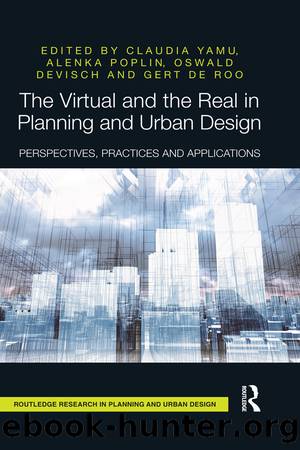The Virtual and the Real in Planning and Urban Design by Yamu Claudia;Poplin Alenka;Devisch Oswald;De Roo Gert;

Author:Yamu, Claudia;Poplin, Alenka;Devisch, Oswald;De Roo, Gert;
Language: eng
Format: epub
Publisher: Taylor & Francis Group
Explaining centrality and measuring accessibility
According to Hillier et al. (2007), cities have a dual nature, with both a foreground and background network. The foreground global network reflects the micro-economic functional pattern. It is the general component of the city and works in the same way independently of any particular culture. For example, the location pattern of shops is attracted to the spatially most integrated streets on various scale levels. The foreground network links urban centres at all scales to each other. In general, the foreground global network gives a European, historically grown cityâs street structure a deformed wheel pattern. The main routes of the network that pass through urban areas hence shape the deformed wheelâs armature. In this way, accessibility, from the cityâs edges to its centre, and the natural interface of co-presence through movement from centres to edges, is made efficient and possible.
Within this network, the growth of settlements entails a reorganization of spatial systems, including the hierarchy of centres and sub-centres, or âcentralityâ and âperipheryâ. Centrality has been revealed as an important factor in understanding the structural characteristics of a complex relational network. It is also relevant to various spatial factors affecting social activity in cities. Centrality, or rather the cascade of different-sized centres, as well as centre and periphery, represents the hierarchical scale of accessibility within a system. Hillier redefined âcentralityâ as âpervasive centralityâ (2012), whereby centrality functions in a diffuse manner throughout the network on all scales (closeness and proximity to smaller and larger centres from a certain location within the city). In this context, space syntax has made the link between the emergent structure and spatial agency, where a cityâs emergent structure is a law-governed process concerning the network of spaces linking buildings together (morphological component) and, in turn, the emergent spatial structure itself has effects on the functional patterns of the city.
At first sight, centrality seems to be something static, and the central area and its boundaries well defined, requiring only the study of the spatial-economic layout. However, when adding temporal aspects, the idea of a stable and clear centre fades: centres shift, expand, shrink or change their focus â and all this occurs in a non-linear manner. Human behaviour, expressed in choices made (e.g. shopping, travel behaviour), also influences the spatial form and plays a role in the constitution of centrality. Space syntax measures the idea of centrality using two logics: âintegrationâ, representing âto-centralityâ, and âchoiceâ, representing âin-between-centralityâ.
Download
This site does not store any files on its server. We only index and link to content provided by other sites. Please contact the content providers to delete copyright contents if any and email us, we'll remove relevant links or contents immediately.
Kathy Andrews Collection by Kathy Andrews(11326)
The remains of the day by Kazuo Ishiguro(8395)
Paper Towns by Green John(4800)
Spare by Prince Harry The Duke of Sussex(4789)
Industrial Automation from Scratch: A hands-on guide to using sensors, actuators, PLCs, HMIs, and SCADA to automate industrial processes by Olushola Akande(4605)
The Body: A Guide for Occupants by Bill Bryson(4585)
Be in a Treehouse by Pete Nelson(3648)
Machine Learning at Scale with H2O by Gregory Keys | David Whiting(3629)
Harry Potter and the Goblet Of Fire by J.K. Rowling(3610)
Never by Ken Follett(3528)
Goodbye Paradise(3446)
The Remains of the Day by Kazuo Ishiguro(3139)
Into Thin Air by Jon Krakauer(3131)
The Cellar by Natasha Preston(3077)
The Genius of Japanese Carpentry by Azby Brown(3040)
Fairy Tale by Stephen King(2949)
120 Days of Sodom by Marquis de Sade(2941)
Drawing Shortcuts: Developing Quick Drawing Skills Using Today's Technology by Leggitt Jim(2940)
The Man Who Died Twice by Richard Osman(2808)
